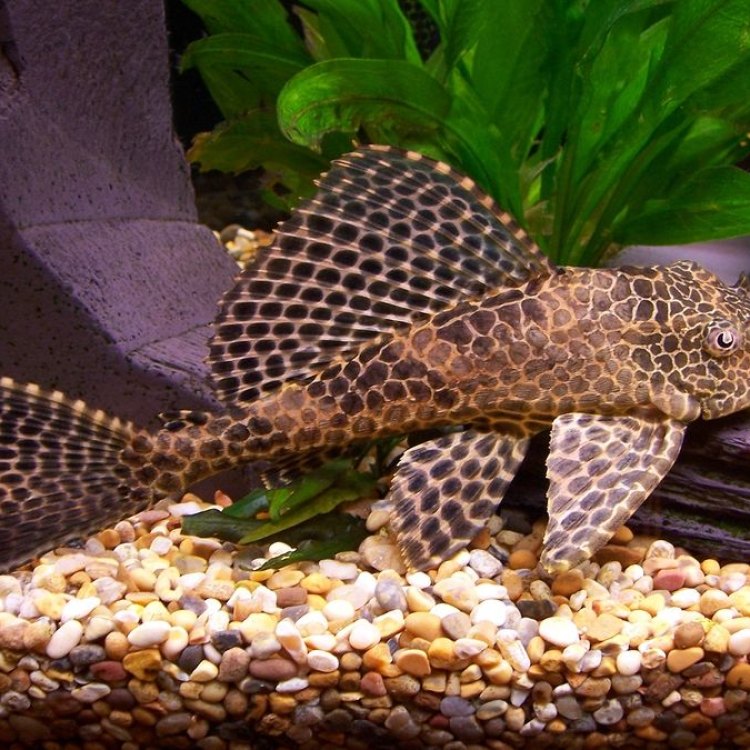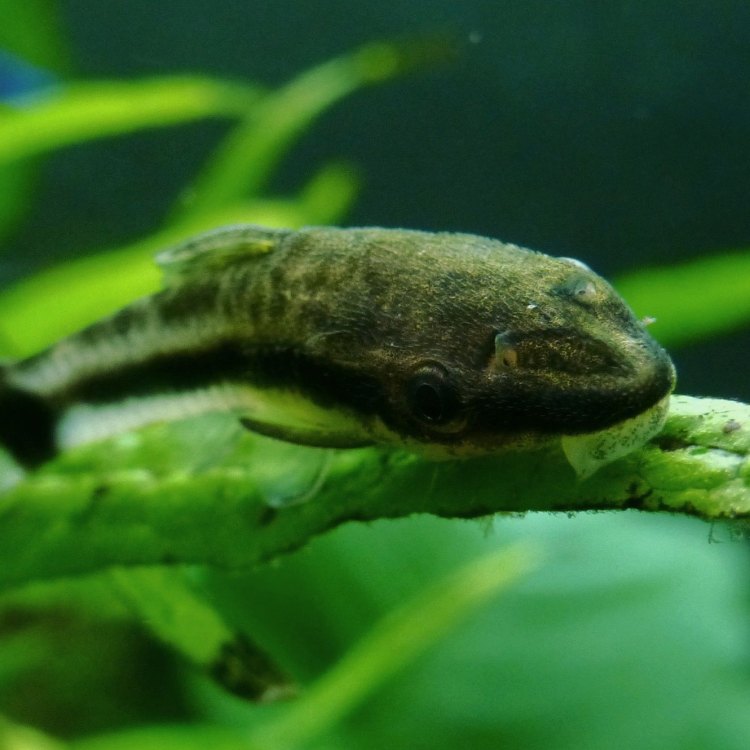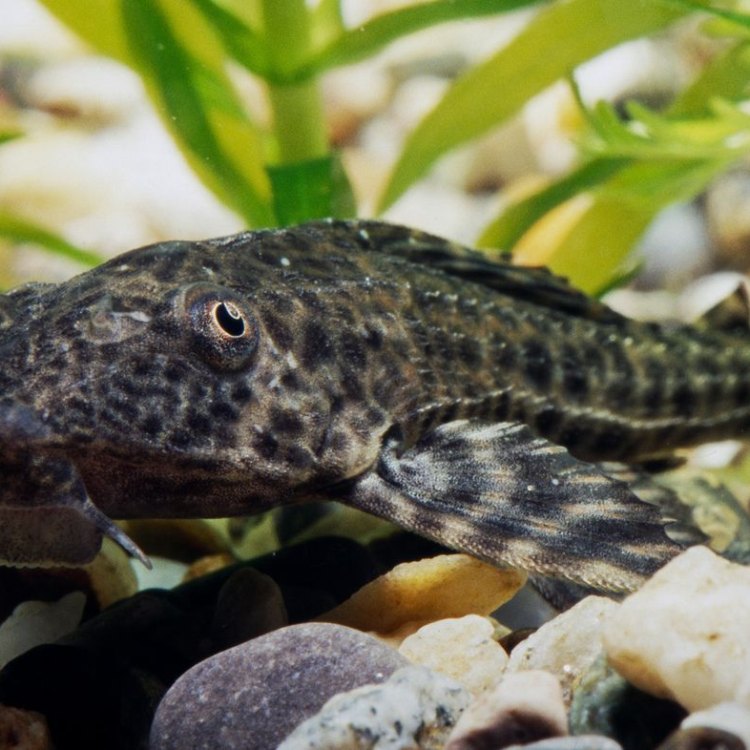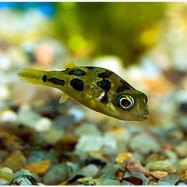
Armored Catfish
Up to 16 inches (40 cm)
The Armored Catfish is a unique species found in the Amazon River basin. With its impressive body shape that is armored and flattened, this fascinating fish can reach up to 16 inches (40 cm) in length. Belonging to the Callichthyidae family, these catfish are a popular sight among fishermen and aquarists due to their hardy nature. #ArmoredCatfish #AmazonRiver #Callichthyidae #aquariumfish
Animal Details Summary:
Common Name: Armored Catfish
Kingdom: Animalia
Habitat: Freshwater
The Amazing Armored Catfish: Surviving the Depths of the Amazon River Basin
The Amazon Rainforest is not only known for its lush greenery, vast biodiversity, and majestic rivers, but it is also home to some of the most unique and fascinating creatures. Among these creatures is the armored catfish, scientifically known as Hoplosternum littorale. This freshwater fish has captured the attention of scientists and enthusiasts with its remarkable features, making it stand out in the animal kingdom.The Discovery of the Armored Catfish
The armored catfish was first discovered in the early 19th century by French zoologist and anatomist Georges Cuvier Armored Catfish. At that time, only the Amazon River basin was known to be the natural habitat of this species. However, as years passed, these catfish were found in other rivers and lakes in South America, such as the Plata River and Orinoco River.The Classification of the Armored Catfish
The classification of the armored catfish is as follows:- Kingdom: Animalia (animals)
- Phylum: Chordata (animals with the dorsal nerve cord)
- Class: Actinopterygii (ray-finned fishes)
- Order: Siluriformes (catfish)
- Family: Callichthyidae (armored catfish)
While catfish are typically known for their whiskers and lack of scales, the armored catfish defies these characteristics. With its hard, bony plates covering its body, it falls under the category of "armored" catfish. This adaptation serves as protection against predators and allows them to thrive in their unique environment.
The Habitat of the Armored Catfish
As mentioned, the primary habitat of the armored catfish is the Amazon River basin in South America. However, they have also been found in other freshwater bodies, such as lakes and rivers, in Brazil, Peru, Ecuador, Bolivia, and Colombia.These catfish prefer slow-moving waters, such as floodplains and oxbow lakes, as they are bottom-dwelling creatures. The dense vegetation in these areas provides them with ample hiding spots and an abundance of food American Coonhound.
The Feeding Behavior of the Armored Catfish
The armored catfish is an omnivorous species, meaning they feed on both plant and animal matter. Their preferred food includes small invertebrates, aquatic plants, and even fruits and seeds found in their habitat. Their specialized mouth, with rows of teeth, allows them to efficiently munch on their food.In addition to being extraordinary bottom feeders, these catfish have another unique feeding behavior. During periods of drought in the Amazon Rainforest, they can survive on plant matter by storing water in their intestine, an adaptation that allows them to survive in harsh conditions.
The Geographical Distribution of the Armored Catfish
The armored catfish is native to South America, specifically the Amazon River basin. However, they have been introduced to other parts of the world, such as Asia and North America, through the aquarium trade. Due to their hardy nature, they have become invasive species in some areas, causing harm to the local ecosystem.The Country of Origin of the Armored Catfish
The country of origin of the armored catfish is Brazil. As they are mainly found in the Amazon River basin, which spans over nine countries, Brazil takes the lead as the country of origin due to its vast portion of the basin.The Appearance of the Armored Catfish
The most distinctive feature of the armored catfish is its hard, bony plates covering its body, resembling armor. These plates run along the length of the fish, providing them with excellent protection against predators. They also have small, sharp spines located on their pectoral and dorsal fins, adding another layer of defense.In terms of coloration, these catfish have a dark brown to gray hue, allowing them to blend in with their environment. This coloration also helps them avoid detection by predators.
The Body Shape of the Armored Catfish
The body of the armored catfish is armored and flattened, giving them a unique appearance compared to other catfish species. This allows them to navigate and seek food among the dense vegetation and potentially rocky river bottom without getting stuck or injured.The Size of the Armored Catfish
The average size of the armored catfish is around 6-8 inches (15-20 cm). However, they can grow up to 16 inches (40 cm), making them one of the larger catfish species. This size is relatively smaller compared to other freshwater fish found in the Amazon River basin.The Movement of the Armored Catfish
The armored catfish is known for its slow and steady movement. As bottom-dwelling creatures, they are not the most agile swimmers, making their motion method slow and sluggish. However, their unique body shape and strong fins make up for this, allowing them to maneuver through their habitat.The Significance of the Armored Catfish in Natural Language Processing
With the advancement of technology, the use of natural language processing (NLP) in various fields, such as healthcare and finance, has been growing rapidly. But did you know that NLP has also been used to study the behavior and communication among animals?One study conducted by a team of researchers from the University of Maryland and Japan's Nagoya University used NLP to analyze the vocalizations of the armored catfish. They recorded their mating calls and found that they produce distinct sounds, differentiating between males and females. This study sheds light on the communication methods used by these fish and how NLP techniques can be applied to understand animal behavior.
Conclusion
The armored catfish, with its unique characteristics, is truly a magnificent creature that has captured the interest of scientists and animal enthusiasts alike. Its armor-like body, ability to survive in different conditions, and its use in NLP research make it a fascinating subject for further study. As we continue to learn more about the Amazon Rainforest and its inhabitants, we can only imagine what other remarkable creatures are waiting to be discovered.

Armored Catfish
Animal Details Armored Catfish - Scientific Name: Hoplosternum littorale
- Category: Animals A
- Scientific Name: Hoplosternum littorale
- Common Name: Armored Catfish
- Kingdom: Animalia
- Phylum: Chordata
- Class: Actinopterygii
- Order: Siluriformes
- Family: Callichthyidae
- Habitat: Freshwater
- Feeding Method: Omnivorous
- Geographical Distribution: South America
- Country of Origin: Brazil
- Location: Amazon River basin
- Animal Coloration: Dark brown to gray
- Body Shape: Armored and flattened
- Length: Up to 16 inches (40 cm)

Armored Catfish
- Adult Size: 8-12 inches (20-30 cm)
- Average Lifespan: 5-8 years
- Reproduction: Sexual
- Reproductive Behavior: Egg-scattering
- Sound or Call: No sound production
- Migration Pattern: Non-migratory
- Social Groups: Solitary
- Behavior: Nocturnal
- Threats: Habitat loss, pollution, overfishing
- Conservation Status: Least Concern
- Impact on Ecosystem: Important for nutrient cycling
- Human Use: Aquarium trade, food source
- Distinctive Features: Armored plates covering body
- Interesting Facts: Can breathe air, move across land
- Predator: Large fish, reptiles, birds

Hoplosternum littorale
The Armored Catfish: A Unique and Versatile Creature
When you hear the word "armored," the first thing that might come to mind is a knight in shining armor, ready to defend and protect. But in the depths of our world's waters, there is a different kind of armored warrior – the Armored Catfish.Found in South America's rivers and streams, these fascinating creatures are known for their distinctive physical features and impressive abilities. From their armored plates to their ability to breathe air and move across land, the Armored Catfish is truly a unique and versatile creature PeaceOfAnimals.Com.
In this article, we will delve deeper into the world of the Armored Catfish and explore its interesting behaviors, threats, and impact on the ecosystem.
The Basics: Size, Lifespan, and Reproduction
The Armored Catfish, also known as the Corydoras catfish, is a medium-sized fish that can reach 8-12 inches (20-30 cm) in length. They have a lifespan of 5-8 years, and like most fish, they reproduce sexually.One interesting fact about the Armored Catfish's reproductive behavior is that they are egg-scattering fish. This means that during spawning season, the female will scatter her eggs throughout the water, and the male will fertilize them. This unique behavior helps to increase the chances of the eggs surviving and hatching.
Nocturnal and Solitary Behavior
The Armored Catfish is a fascinating creature, not just for its physical appearance, but also for its behavior. These fish are known to be nocturnal, meaning they are most active at night. This behavior helps them avoid predators and allows them to forage for food without competition African Jacana.Another notable behavior of the Armored Catfish is that they are solitary creatures. They prefer to live alone and will only come together during the breeding season. This also helps them avoid competition for food and territory.
The Armored Plates: A Unique Defense Mechanism
What sets the Armored Catfish apart from other fish is its distinctive physical feature – the armored plates covering its body. These plates, made of bone-like material, are fused together to form a protective shield for the fish.Not only do these plates offer protection from predators, but they also serve as an effective camouflage. With their brown or gray coloration, it is easier for the Armored Catfish to blend in with their surroundings and avoid detection.
Interesting Facts: Land and Air Abilities
The Armored Catfish is not your average fish. One of the most interesting facts about this creature is its ability to breathe air and move across land. This unique adaptation allows them to survive in areas with low oxygen levels or during droughts when water levels are low.They achieve this by swallowing air at the surface and passing it through their intestinal tract to their swim bladder, where oxygen is extracted. They then release the air through their gills, allowing them to oxidize their blood and continue breathing. This impressive ability has earned them the nickname "walking fish."
Threats and Conservation Status
Like many other aquatic creatures, the Armored Catfish faces several threats, including habitat loss, pollution, and overfishing. With human development and deforestation increasing in South America, the Armored Catfish's natural habitat is rapidly declining.Additionally, pollution from agricultural and industrial activities can have detrimental effects on the water quality, making it difficult for the fish to survive. Overfishing is also a significant threat, as the Armored Catfish is a popular food source in South America and is also in high demand in the aquarium trade.
Despite these threats, the Armored Catfish is currently listed as "Least Concern" on the IUCN Red List, which means it is not facing significant risk of extinction. However, it is essential to continue monitoring their population and implementing conservation measures to ensure their survival in the future.
Importance in the Ecosystem
The Armored Catfish may be small in size, but it plays a crucial role in the ecosystem. As bottom-dwelling fish, they help to maintain a healthy ecosystem by feeding on decaying plant matter, algae, and insects. In turn, their waste provides essential nutrients for the growth of aquatic plants, creating a balanced ecosystem.These fish also serve as a food source for larger fish, reptiles, and birds, thus contributing to the food web. Furthermore, their land and air abilities make them ideal dispersers of nutrients in the surrounding land areas when they move across the land.
Human Use: Aquarium Trade and Food Source
The Armored Catfish has become a popular choice for aquarium enthusiasts due to its unique appearance and peaceful nature. They are relatively low maintenance and can coexist with a variety of other fish in a tank.In South America, the Armored Catfish is also a significant food source, as mentioned earlier. They are a nutritious protein source and are a staple in many local diets.
However, it is vital to consider the population and sustainability of these fish in their natural habitat before using them for human purposes. The aquarium trade should be regulated, and sustainable fishing practices should be implemented to ensure the Armored Catfish's survival.
Predators of the Armored Catfish
Despite their protective armor, the Armored Catfish is not entirely invincible. Their main predators include larger fish, reptiles, and birds. These creatures can easily outswim and outmaneuver the Armored Catfish and feed on them as a source of food.To protect themselves, the Armored Catfish has developed an interesting behavior known as "playing dead." When threatened, they will lie on their side and remain still, mimicking a dead fish. This technique can sometimes deceive their predators, giving them a chance to escape.
In Conclusion
The Armored Catfish is a truly remarkable creature with several unique features and abilities. From its distinctive physical appearance to its nocturnal and solitary behavior, this fish has captivated the interest of many. However, with increasing threats to their habitat, it is our responsibility to ensure the survival of these fascinating fish.By understanding the Armored Catfish's role in the ecosystem and implementing sustainable fishing practices, we can help protect and preserve this vital species. Let us appreciate and admire the incredible adaptations and abilities of the Armored Catfish, but also remember to protect and conserve them for future generations to come.

The Amazing Armored Catfish: Surviving the Depths of the Amazon River Basin
Disclaimer: The content provided is for informational purposes only. We cannot guarantee the accuracy of the information on this page 100%. All information provided here may change without prior notice.












